----------------------- The Blue Ensigns -----------------------
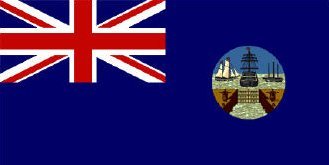 Blue Ensign of Bermuda Blue Ensign of Bermuda No organized system of colonial flags existed until 1865 when the Admiralty ruled that the flag that should be worn by any vessel maintained by a colony under the terms of the Colonial Naval Defence Act should be a Blue Ensign with the Seal or Badge of the colony in the centre of the fly. The vessel should additionally wear a Blue Pennant unless it was not commissioned as a vessel of war when the ensign would be worn without the pennant.
----------------------- The Flags of Governors -----------------------
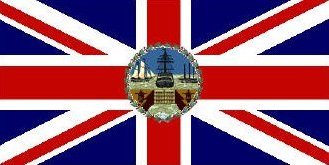 Governor General of Bermuda Governor General of Bermuda A further series of colonial flags was authorised in 1869 for the use of colonial governors when embarked in a vessel on waters within their jurisdiction; the Arms or Badge of the colony encircled by a garland in the centre of a Union Jack.
|
|
|
Governor General of Victoria |
|
Blue Ensign of Victoria |
Where a colony needed both flags, the same badge should have been used on each one, but at first this requirement was not always observed.
|
|
|
Lieutenant-Governor General of Nova Socia |
|
Blue Ensign of Grenada 1903-1974 |
Some badges that were used on the flags of governors were not used on ensigns and vice versa. Examples would include Nova Socia and Grenada.
----------------------- The Design of the Badges -----------------------
The governor of a colony submitted a drawing of the proposed badge of the colony to the Colonial Office which consulted the Admiralty before approving the design. Few colonies had Arms, none had a Badge, but all had a Public Seal that followed a standard pattern; the Royal Arms above a panel that contained an allegorical scene or landscape relevant (more or less) to the colony.
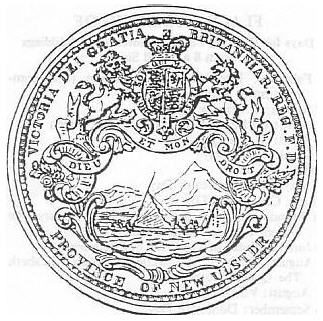 Seal of New Ulster Seal of New Ulster In the Nineteen-Twenties and Thirties badges were designed by the Royal Mint Advisory Committee that was responsible for the production of coins,
medals and decorations. Sixty-five different badges were in use in 1949 when the British Commonwealth was renamed The Commonwealth of Nations. Twenty-seven were Arms or elements of Arms, twenty-two were derived from Seals and fourteen were royal emblem, star, word/initial combinations. The total number of badges decreased as
colonies gained independence, but twenty-three new badges were created for territories that had been parts of former federal colonies. These badges were now almost exclusively based upon Arms granted and designed by the College of Arms, which also revised seven existing badges.
Twenty-four of the fifty flag badges authorised up to 1880 were based upon the pictorial panel of the Seal, and nine were Arms, or elements of Arms.
|
|
|
|
|
Seal of Falkland Islands
(based on seal) |
|
Seal of Cape Colony
(based on arms) |
|
Seal of Quebec
(based on elements of arms) |
The scene on the Seal could not always be adapted to make a satisfactory badge, and approval was also given for original designs that were not based on the Seal or Arms as shown below. Usually these were crowns or other royal emblems, often in combination with words, initials or stars.
|
|
|
Seal of Fiji |
|
Seal of Western Pacific High Commission |
At the beginning of the 20th century colonies were encouraged to apply for Arms. Not many did, as governors of smaller colonies considered that the cost, born by the colony, could not be justified. Those that were granted Arms used them, or part of them, as the badge on the ensign.
|
|
|
Seal of Fiji |
|
Seal of Tanganyika |
In the Nineteen-Twenties and Thirties badges were designed by the Royal Mint Advisory Committee that was responsible for the production of coins, medals and decorations.
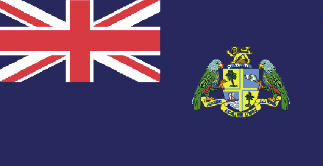 Blue Ensign of Dominica Blue Ensign of Dominica
(badge designed by Royal Mint) Sixty-five different badges were in use in 1949 when the British Commonwealth was renamed The Commonwealth of Nations. Twenty-seven were Arms or elements of Arms, twenty-two were derived from Seals and fourteen were royal emblem, star, word/initial combinations. The total number of badges decreased as colonies gained independence, but twenty-three new badges were created for territories that had been parts of former federal colonies. These badges were now almost exclusively based upon Arms granted and designed by the College of Arms, which also revised seven existing badges.
|
|
|
Blue Ensign of British Somaliland (old) |
|
Blue Ensign of British Somaliland (new) |
----------------------- The Size of the Badges -----------------------
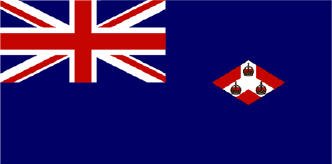 Blue Ensign of the Straits Settlements Blue Ensign of the Straits Settlements The badge on both ensigns and on Union Jacks was placed inside a circle with a diameter that was four-ninths the length of the hoist of the flag. Those badges that were not circular were set in an imaginary circle of this size.
|
|
|
Blue Ensign of New Zealand |
|
Blue Ensign of Tristan da Cuna |
Some ensign badges never conformed to this restriction such as the Blue Ensign of New Zealand, and since 1999, there has been no restriction on the size of any ensign badge. An example of one of these newer ensigns would be the Blue Ensign of Tristan da Cuna.
----------------------- The Use of White Discs -----------------------
|
|
|
Blue Ensign of Nyasal (with disc) |
|
Incorrect Blue Ensign of Nyasal (without disc) |
Those non-circular badges that were not clearly visible against the blue or red field of an ensign were placed upon a white disc of the specified diameter. In the Admiralty and Colonial Office flag books the pages showing colonial badges consisted of rows and columns of white circles onto which the badges were printed. As a result it was often thought that all badges that were not circular had to be set on a white disc. An unsuccessful attempt to resolve this misunderstanding was made in the early 1920s when the Admiralty, in consultation with the Colonial Office and relevant governor, stipulated which badges should be on a white disc and which should not.
----------------------- The Red Ensigns -----------------------
 Red Ensign of Cambay Red Ensign of Cambay It was also often wrongly thought that there was a corresponding Red Ensign for every colonial Blue Ensign. A plain Red Ensign, as used by British merchant ships, was the proper ensign of any vessel registered in a British colony. It was only in protectorates and mandated territories whose inhabitants were not British subjects and were not entitled to sail under the plain Red Ensign that, where necessary, a warrant was issued for a Red Ensign with the badge of the territory in the fly.
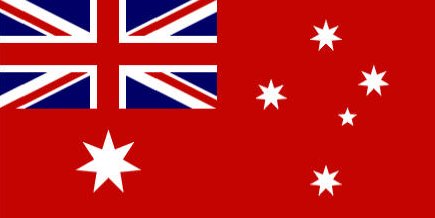 Red Ensign of Australia Red Ensign of Australia Warrants were also issued for colonies which became self-governing Dominions.
----------------------- Admiralty Warrants -----------------------
Blue Ensigns with a badge in the fly could be authorised by correspondence between the Admiralty, Colonial Office and relevant governor. Red Ensigns were regulated by Parliament through various Merchant Shipping Acts and required specific authorisation by Admiralty Warrant, as did Blue Ensigns of chartered companies.
----------------------- Use of Flags on Land -----------------------
The land flag of a colony was the Union Jack, but by the end of the 19th century defaced ensigns, usually red and often unauthorised, were being flown on land. The need for a distinctive flag at international sporting events also led to increasing use on land of colonial Blue Ensigns. The use of ensigns on land was also encouraged by the widespread belief that the Union Jack, which was always flown over Government House, was the flag of the governor and should not be flown by anyone else. In 1941, to encourage wider use of the Union Jack, the Colonial Office directed that the Union Jack with the colonial badge in its centre was the flag of the governor in all circumstances, and not solely for use when embarked.
|